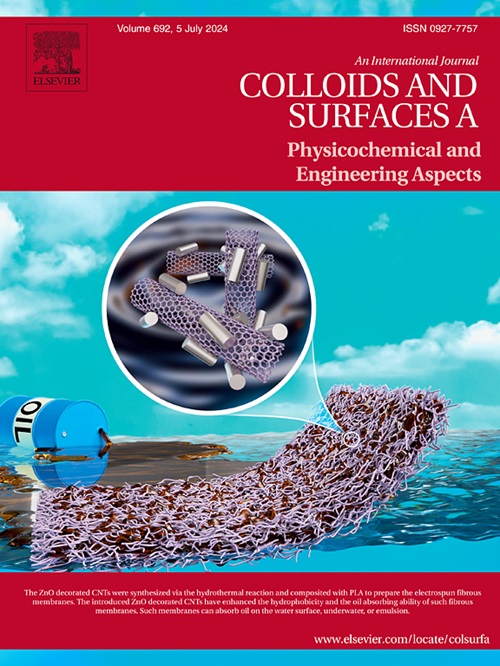Highly efficient β-Bi2O3/Bi battery electrodes by reactive annealing from sol-gel precursors
IF 4.9
2区 化学
Q2 CHEMISTRY, PHYSICAL
Colloids and Surfaces A: Physicochemical and Engineering Aspects
Pub Date : 2024-11-09
DOI:10.1016/j.colsurfa.2024.135738
引用次数: 0
Abstract
The need of achieving low-impact and low-cost functional materials through sustainable and efficient methodologies is one of the goals of the current research in the field of materials science and energy storage. In this study, a new facile route for obtaining battery-like electrode Bi-based films is presented. Specifically, ∼1.3 μm-thick β-Bi2O3 films were prepared from oxynitrate via a simple sol-gel/elution process upon titanium foils, followed by annealing in forming gas at 350°C. A multi-technique approach, involving Raman, X-ray Photoelectron Spectroscopy, X-ray Diffraction, Scanning Electron Microscopy and optical characterization, demonstrates the formation of a nanocrystalline porous bismuth oxide (20–30 nm in size) consisting of β-Bi2O3 phase with the crucial presence of Bi0. Annealing at 350°C in different environments (i.e. air and N2), do not produce crystalline phases. The reported method improves the synthesis of β-Bi2O3 phase through a ∼1.3 μm-thick film realization and a controlled phase production by reactive annealing at moderate temperatures. Cyclic Voltammetry and Galvanostatic Charge Discharge analyses reveal a double-redox behaviour for the β-Bi2O3 /Bi0 battery electrode with a specific capacity (capacitance) of 195 mA*h/g (350 F/g) at 0.5 A/g. The data highlight the promising usage of sol-gel/elution for the realization of ∼1.3 μm-thick film for energy storage applications.
利用溶胶-凝胶前驱体的反应性退火技术制备高效 β-Bi2O3/Bi 电池电极
通过可持续和高效的方法获得低影响、低成本的功能材料,是当前材料科学和储能领域的研究目标之一。本研究提出了一种获得类电池电极铋基薄膜的新方法。具体来说,通过在钛箔上进行简单的溶胶-凝胶/洗脱过程,然后在 350°C 的成型气体中进行退火,制备了厚度为 1.3 μm 的β-Bi2O3 薄膜。通过拉曼光谱法、X 射线光电子能谱法、X 射线衍射法、扫描电子显微镜法和光学表征法等多种技术方法,证明形成了由 β-Bi2O3 相组成的多孔纳米晶氧化铋(大小为 20-30 纳米),同时还存在重要的 Bi0。所报道的方法通过实现 1.3 μm 厚的薄膜,以及在中等温度下通过反应退火控制相的生成,改进了 β-Bi2O3 相的合成。循环伏安法和电静态充放电分析表明,β-Bi2O3 /Bi0 电池电极具有双重氧化还原行为,在 0.5 A/g 条件下,比容量(电容)为 195 mA*h/g(350 F/g)。这些数据凸显了溶胶-凝胶/沉淀法在实现 1.3 μm 厚薄膜储能应用方面的前景。
本文章由计算机程序翻译,如有差异,请以英文原文为准。
求助全文
约1分钟内获得全文
求助全文
来源期刊
CiteScore
8.70
自引率
9.60%
发文量
2421
审稿时长
56 days
期刊介绍:
Colloids and Surfaces A: Physicochemical and Engineering Aspects is an international journal devoted to the science underlying applications of colloids and interfacial phenomena.
The journal aims at publishing high quality research papers featuring new materials or new insights into the role of colloid and interface science in (for example) food, energy, minerals processing, pharmaceuticals or the environment.

 求助内容:
求助内容: 应助结果提醒方式:
应助结果提醒方式:


